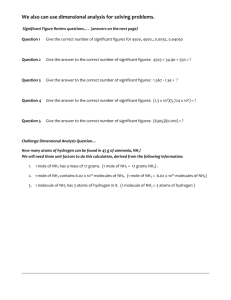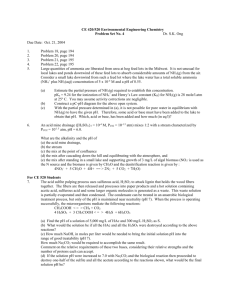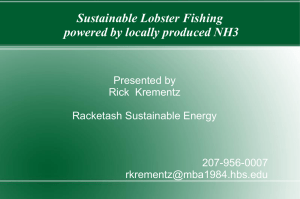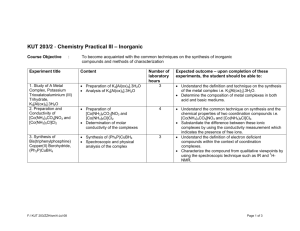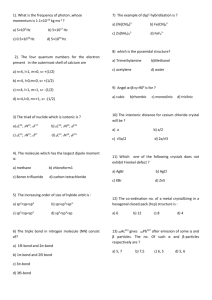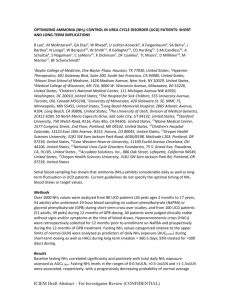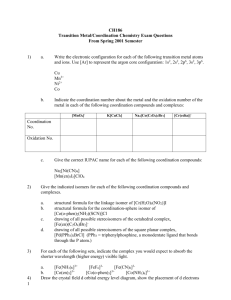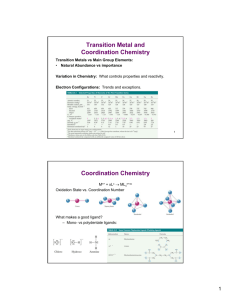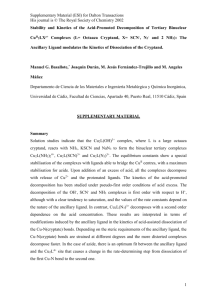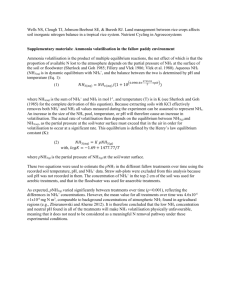Trasition metals, Pt
advertisement
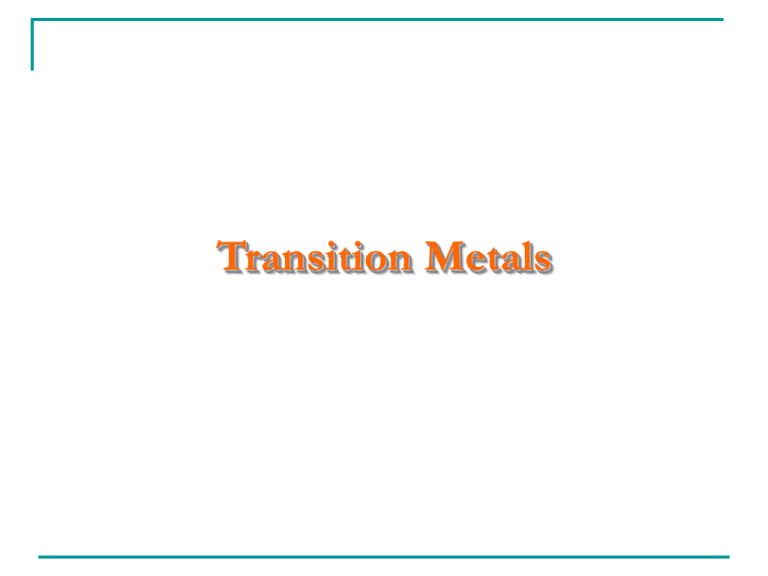
Transition Metals Periodic Table bulk elements for some species trace elements General roles of metal ions in biology Na, K: Charge carriers Osmotic and electrochemical gradients Nerve function Mg, Ca: Enzyme activators Structure promoters Lewis acids Mg2+: chlorophyll, photosynthesis Ca2+: insoluble phosphates Fe, Cu, Mo: Electron-transfer Redox proteins and enzymes Oxygen carrying proteins Nitrogen fixation Zn: Metalloenzymes Structure promoters Lewis acid Not a redox catalyst! Other metal ions: less well defined and more obscure roles Biochemical Reactivity Promotion of Appropriate Geometry Change acid/base character Change Redox potentials Change ionic concentration Formation of Unique species Formation of structural materials Activation of small molecules (NO) Fe(II), Fe(III): Essential for ALL organisms In plants: iron deficiency In human body: 4-5 g Uptake: ~ 1 mg/day In human body 75% Hem-iron Hemoglobin Myoglobin Cytochromes Oxidases, P-450 25% Non-hem-iron Rubredoxins Ferredoxins Porphyrins Fe Oxygen Transport Hemoglobin 4 Fe containing globin units (2-alpha and 2-beta) K increases with each O2 added Fe(II) does not oxidize to Fe(III) Non-aqueous or simultaneous Oxygen to two hemes. Oxygen Storage Myoglobin 1 heme group Porphyrin Hemoglobin Fe Iron Environment in Myoglobin Cytochromes, Peroxidases, and Catalases Cytochrome P-450 Oxidation catalyst Peroxidases/Catalases Decomposition of organic peroxides. Electron Transfer Chains Other Fe Compounds Ferritin / Transferrin Iron storage in spleen, liver and marrow. Mw 445,000 (4,300 Fe atoms) Periodic Table bulk elements for some species trace elements Cu(I), Cu(II) Plants Animals Electron transfer O2-carrying Protection of DNA from O2- Cu-proteins and enzymes Cytochrome oxidase O2 H2O Tyrosinase, phenol oxidase ox. of phenols Ceruloplasmin Fe(II) Blue proteins Electron transfer Superoxide dismutase Elimination of O2- Hemocyanin O2 transport Fe(III) Superoxide Dismutase SOD-Cu2+ + O2.- SOD-Cu1+ + O2 SOD-Cu1+ + O2.- + 2H+ SOD-Cu2+ + H2O2 Oxygen hemocyanin mollusks and arthropods Copper-related Pathological Disorders 1. Wilson’s disease: Hereditary disfunction of ceruloplasmin Cu2+ accumulates in liver, brain: dementia, liver failure Administration: Cu-specific chelate 2. Menke’s „kinky hair” syndrome: Hereditary disfunction of intracellular copper transport Copper deficiency symptoms: disturbances in the mental and physical development Therapy: intravenously administered copper compounds 3. Acute copper deficiency Insufficient oxygen utilization in brain 4. Mutations in the copper dependent superoxide dismutase Ni(II) Ni-containing enzymes of bacteria Urease CO-dehydrogenase Hydrogenases (Vesicle) Membranes Mo HPO42- Uptake : MoO42SO42- Molybdenium enzymes Nitrogenase N2 NH3 Aldehyde oxidases -CHO -COOH Nitrate reductase NO3- NO2- Sulfide oxidase SO32- SO42- Xanthin oxidase purin catabolism Formate dehydrogenase H-COO- CO2 Platinum Complexes in Cancer Therapy Cl NH3 NH3 Pt Cl Cl Pt NH3 Cis-dichlorodiammineplatinum (II) Blocking cell division Cl NH3 Trans-dichlorodiammineplatinum (II) inactive Cl Cl Cl Cl NH3 Pt Pt Cl NH3 Cl Cis-tetrachlorodiammineplatinum (IV) biologically active NH3 NH3 Cl Cl Trans-tetrachlorodiammineplatinum (IV) inactive Platinum Complexes in Cancer Therapy NH3 NH N H33 Cl Pt NH3 NH N H33 PPtt Cl Cisplatin NN O N H2 N N N HN HN N N O N H2 NH 2 N Platinum Complexes in Cancer Therapy Protein P rot ein Pt Pt G NNH H 33 Pt Pt G NNH H 33 a G N H3 NH 3 b NNH H 33 Injection Blood Toxic side effect Cytostatic effect Plasma proteins Blood stream Kidney Other organs Liver Excretion Tumor cells Activity of Pt(NH3)2X2 complexes X Activity NO3- toxic H2O toxic Cl- antitumor Br- antitumor I- inactive SCN- inactive NO2- inactive CN- inactive (X = ligand) O C O Pt C O N H3 N H3 O a Pt-chelate complex (considerable antitumor activity)

